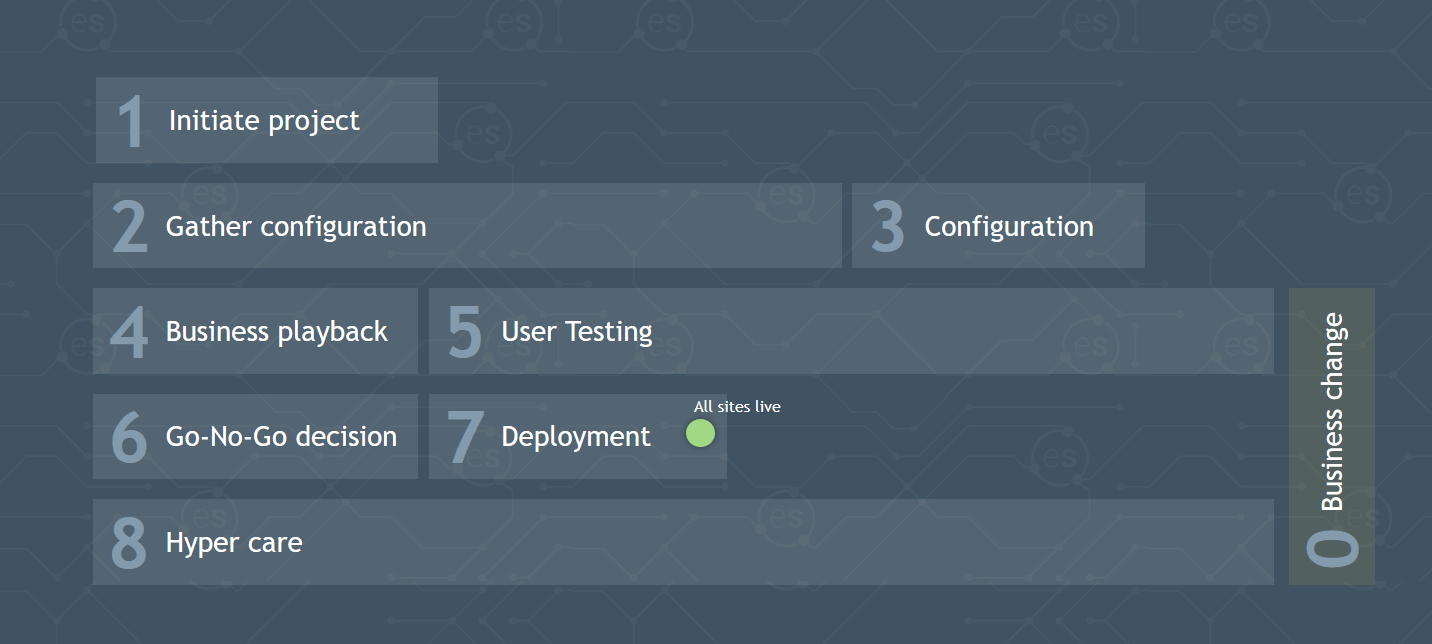HR technology can significantly help HR teams improve operational efficiency and performance. It can also substantially elevate staff engagement, improve talent retention rates and lift the burden of manual tasks. But many companies are not realising the game-changing benefits of implementing new HR technology. The thought of overhauling legacy systems is a daunting task. And successful implementations can take a lot of time, but they shouldn’t.
Yes, it can be challenging to implement new HR technology into the workplace, and get it right, let alone tackle this with both client and vendor teams working from home. An article from Josh Bersin suggests that ‘HR technology is harder to implement than ever’ but it doesn’t need to be that way. When you couple this with the recent PWC research that suggests that 74% of companies plan to increase their spend on HR tech, the trick is how to implement successfully, faster and remotely.
Read 7 HR technology trends for 2025.
Successful HR technology implementation
So how do you effectively implement HR technologies? For many, working from home has allowed them to be more productive, but that isn’t the case for everyone. How should we set things up to take advantage of the increased productivity to accelerate HR technology implementation effectively?
The success of a new people system depends on a number of key aspects. Many HR professionals will be first timers at implementing technology into HR. Here are seven tips to help you avoid potential hurdles and ensure a smooth implementation, that see’s everyone benefiting faster.
1. Choose an out of the box solution
An out-of-the-box solution that’s highly configurable and easy to use, but doesn’t remove your options and flexibility. With this approach you’re simply configuring the solution according to your business needs. Match your list of requirements with the solution will make implementation fast. This also ensures you don’t miss anything or forget important elements of your business processes. This will give you a transparent approach from the start.
There are some amazing and measurable benefits from this approach, not least that you require a lot less involvement and time from your team. Which means an implementation can be closer to 90 days, and not the daunting months and years that many experience. It simply doesn’t need to be that way.
If shorter timelines is your goal, which so many business want, then you’ll need to give some thought to your business process impact and your approach to change management. There are significant benefits to be gained, when you are not running a seemingly endless implementation project.
2. Be 100% sure you know what you are buying?
Choosing your HR technology is a little like shopping for your new smartphone. Would you choose a new smartphone without investing some thought into how you plan to use it, your priorities and what’s most important to you? Probably not.
This might seem a little obvious, but its easy to be wowed by features, so make sure they align to your business needs and goals. Look at the features through the lens of all your staff at all levels.
Agree your feature list up front, this saves time as you progress through the project and creates 100% transparency on both sides – vendor and client. This will also help you manage the costs of the project (fixed costs). By agreeing your feature at commencement, its easy to refer back and tick off everything before going live, ensuring nothing is missing.
This approach is what we call ‘locked and loaded’. Its what speeds up project deployment, but also delivers on project transparency every step of the way.
3. Embrace technology to make remote collaboration feel easy
Delivering complex projects remotely comes with a whole new set of challenges and frustrations, but in reality, this should mean greater focus and greater efficiencies. Improvements across the technology space have made things possible we wouldn’t have thought achievable 5 years ago. Off the shelf tools enable easier remote collaboration such as Google Meet (previously Google Hangouts), Slack, Microsoft Teams, Zoom, and Invision, with many coming with associated whiteboard options. And of course, Zapier to connect everything if you need to.
Remote collaboration means embracing technology to manage the process. You may miss your walls filled with post-it notes and 4-6 hour workshops for experts, but trying to recreate these online (despite the above) is just not practical. Try to split these sessions and workshops into 1 ½ – 2 hours at a time and run over several sessions if you need to. This will avoid the inherent fatigue that comes from these, which is intensified when meeting online.
And although these tools are great you will need to be mindful, they do not replace the visual cues you get from body language or help you accurately gauge underlying tone of voice. Even the tone in written word can be misinterpreted as more and more of us use abbreviations and language that might look more at home on an SMS. You will need to hone your participation and inclusiveness skills to tease out that important piece of information that only the quietest person on the call holds.
4. Do what you’re good at…
Stated simply…The business team know the business, the vendors know their tech. If you’re on the client side, you need to manage your internal stakeholders well and protect the project. Manage expectations within the business, people don’t just hear what you said – they also hear what they want to. This can lead to unrealistic expectations trying to deliver things that you simply can’t, leading to a frustrated, and potentially an antagonistic user base.
If you’re on the vendor side then you need to deliver on your commitments, deadlines are vital to your client. The impact of a missed deployment can be more than significant. Vendors will be focused on delivering on time, particularly if it’s a fixed cost project rather than ‘time and materials’. Vendors do these types of projects all the time – make sure you ‘make it easy to do it right’.
5. Right people, right place, right time
HR leaders are looking to see the value and results faster than ever. It goes without saying that a clear and transparent project plan is an absolute. One that tightly defines each task within the project, including interdependencies, resources and owners. This will mitigate against wasting valuable time and ensure you have the right people, in the right place at the right time.
Good vendors will have a template plan which you can fit around your key business dates. Try to utilise this rather than re-write your own. Vendors plans should be accessible and updated in real time. This ensures everyone is on the same page at the same time and nothing comes as a surprise.
Complete project progress transparency is rare, but something that’s key to delivering implementation on time and fast. There is no reason why a fixed cost SaaS implementation should not work this way.
Put contingency in your plan to allow for slippage, be realistic rather than optimistic and manage expectations accordingly. Deal with bad news in a way that encourages transparency from all rather than push people to hiding their delays – otherwise this will lead to worse news further down the track.
6. Project implementation methodology
Your out-of-the-box option should come with a systematic deployment methodology, which reduces costs and reduces time. A little like your smartphone purchase, which comes with a standard set of instructions.
Managing costs is a significant requirement for businesses today who are operating in a more budget restrained environment. So often businesses employ external project managers and consultants to oversee implementations. But this new era of smart deployment methodology, mitigates that need. A systematic project management process with transparent mile stones saves you both time and cost.
The ‘lock and loaded’ methodology that elementsuite uses ensures transparency from the start. This process also ensures the effective and efficient use of the technology across your business and users. The additional benefits are high adoption rates early, post implementation.

elementsuite Implementation Methodology
7. Agile deployment methods
Agile deployment is a great way to involve users, improve user adoption and tailor your chosen technology to your business needs and processes.
This means that after less time and fewer sessions you are up and running with a first version, allowing you to use and test as you go. Involving different teams to test within the process gives early signals if changes need to be made – they can happen fast.
When it comes to successful remote implementation, this approach speeds up the process, but not at the expense of adapting to business needs and the user experience.
Make sure your out-of-the-box solution gives you room to grow. No matter what you choose, think about where your business might be in 5 or 10 years time, which is harder in uncertain times. HR technology should not be static. Ensure that any enhancements and improvements to the technology are made available to you as standard, without additional costs. Your choice should enable scalable growth with services and features that help your business achieve its goal and adapt to its needs as they evolve.
Successful remote implementation
This may feel like a pipedream, but the reality is 100% achievable. You need to leave egos at the door and the I’m too busy’ has to be put to one side. Adopting a ‘can-do’ project behaviour which is more about “tell me what I need to do by when” from all involved in the project.
Deploying remotely is achievable in a matter of days (our record at elementsuite is 5 days) rather than months. Remote deployment requires a systematic approach, seamlessly connecting with teams and collaborators, strong governance with transparency, minimising disruption.
HR technology is easier than ever to implement.




